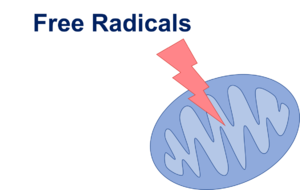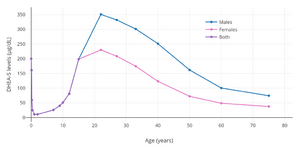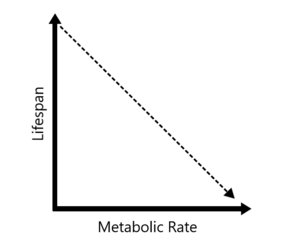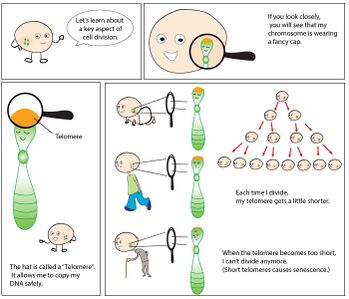Theories of Ageing: Difference between revisions
Jasrah Javed (talk | contribs) No edit summary |
No edit summary |
||
| (17 intermediate revisions by 2 users not shown) | |||
| Line 4: | Line 4: | ||
'''Top Contributors''' - {{Special:Contributors/{{FULLPAGENAME}}}} | '''Top Contributors''' - {{Special:Contributors/{{FULLPAGENAME}}}} | ||
</div> | </div> | ||
== | == Introduction == | ||
[[ | [[Older People Introduction|Ageing]] is a ubiquitous, intrinsic and ongoing process. Theories of ageing have been debated since the time of the ancient Greeks, and researchers now feel that no one theory exists that explains all aspects of ageing. Instead several theories may be combined to explain various aspects of the complex phenomena we call ageing .<ref>Viña J, Borrás C, Miquel J. [https://iubmb.onlinelibrary.wiley.com/doi/abs/10.1080/15216540601178067 Theories of ageing]. IUBMB life. 2007;59(4‐5):249-54. Available:https://iubmb.onlinelibrary.wiley.com/doi/abs/10.1080/15216540601178067 (accessed 1.12.2022)</ref> | ||
Why do we grow old? In recent years, scientific research has established some really interesting biological ageing theories. Why we age at the cellular level. This video looks 12 theories current on the causes of ageing, namely: Genome damage to DNA; Telemere shortening; epigenetic malfunctions; Misfolding of proteins; Cell senescence; Stem cell exhaustion; Glycation; AMPK pathways; [[Inflammaging]]; MTOR pathways; Sirtuins (longivity genes). Some of these theories are outlined later. | |||
{{#ev:youtube|https://www.youtube.com/watch?v=CprWXAQZRTc|width}}<ref>Lance Hitchings. Biological Aging Theories | Causes Of Ageing Available from: https://www.youtube.com/watch?v=CprWXAQZRTc (last accessed 2.12.2022)</ref> | |||
== Categories: Ageing Theories == | |||
Ageing may be seen as a sequence of events that occur from conception to death. Categories of ageing theories all seek to explain and explore the many dimensions of ageing. | |||
# '''Biologic''': Interested with answering fundamental questions with respect to the physiologic processes that occur in all living organisms over time (Hayflick, 1996). | |||
# '''Sociologic''': Looking at the roles and relationships within which individuals engage in later life. | |||
# '''Psychologic''': Controlled by biology and sociology; address how a person responds to the engagements of their age. | |||
# '''Moral/Spiritual''': Study how individuals seeks to validate his or her existence.<ref name=":4">Nurse key Theories of Ageing Available:https://nursekey.com/theories-of-aging-3/ (accessed 2.12.2022)</ref> | |||
== Biological Theories of Ageing == | |||
Biologic theories are concerned with answering questions regarding the physiologic processes that occur in all living organisms as they chronologically age. These age-related changes arise independent of any external or pathologic effects, and the quest is to uncover these inciting factors that cause the actual ageing process in organisms. | |||
'''The Programmed Theories''' | |||
# '''Programmed Longevity''', which considers ageing to be the result of a sequential switching on and off of certain genes, with senescence being defined as the time when age-associated deficits are manifested. | |||
# '''[[Endocrine System|Endocrine]] Theory''', where biological clocks act through hormones to control the pace of ageing. | |||
# '''Immunological Theory''', which states that the [[Immune System|immune system]] is programmed to decline over time, leading to an increased vulnerability to infectious disease and thus ageing and death. See [[immunosenescence]] | |||
[[ | ==== Damage or Error Theories ==== | ||
[[File:Free radical damage.png|thumb|Free Radicals]] | |||
Include: | |||
#'''The [[Free Radicals|Free Radical]] Theory: I'''mplicates the gradual accumulation of oxidative cellular damage as a fundamental driver of cellular aging. This theory has evolved over time to emphasize the role of free radical induced [[mitochondria]]<nowiki/>l DNA (mtDNA) mutations and the accumulation of mtDNA deletions. Given the proximity of mtDNA to the electron transport chain, a primary producer of free radicals, it postulates that the mutations would promote mitochondrial dysfunction and concomitantly increase free radical production in a positive feedback loop. It is known that diet, lifestyle, drugs (e.g. tobacco and alcohol) and radiation etc., are all accelerators of free radical production within the body.<ref name=":0">Weinert BT, Timiras PS. [https://www.physiology.org/doi/pdf/10.1152/japplphysiol.00288.2003 Invited review: theories of aging]. Appl Physiol. 2003; 95: 1706–1716. Accessed 25 September.</ref> | |||
# '''Error theory''': based on the idea that errors can occur in the transcription of the synthesis of DNA. These errors are perpetuated and eventually lead to systems that do not function at the optimum level. The organism’s aging and death are attributable to these events (Sonneborn, 1979). | |||
#'''The Cross-Linking Theory''':<ref>Zs.-Nagy I, Nagy K. On the role of cross-linking of cellular proteins in aging. Mech Ageing Dev. 1980; 14 (1–2): 245-251. | |||
</ref> also referred to as the Glycosylation Theory of Aging. In this theory it is the binding of glucose (simple sugars) to protein, (a process that occurs under the presence of oxygen) that causes various problems. Once this binding has occurred the protein becomes impaired and is unable to perform as efficiently. Living a longer life is going to lead to the increased possibility of oxygen meeting glucose and protein and known cross-linking disorders include senile cataract and the appearance of tough, leathery and yellow skin. | |||
#'''The Neuroendocrine Theory'''<ref name=":0" /><ref>Dean W. Neuroendocrine Theory of Aging: Chapter 2 Adaptive Homeostat Dysfunction. Accessed 25 September 2018 from<nowiki/>https://warddeanmd.com/articles/neuroendocrine-theory-of-aging-chapter-2/</ref> First proposed by Professor Vladimir Dilman and Ward Dean MD, this theory elaborates on wear and tear by focusing on the neuroendocrine system. This system is a complicated network of biochemicals that govern the release of hormones which are altered by the walnut sized gland called the hypothalamus located in the brain. The hypothalamus controls various chain-reactions to instruct other organs and glands to release their hormones etc. The hypothalamus also responds to the body hormone levels as a guide to the overall hormonal activity. But as we grow older the hypothalamus loses it precision regulatory ability and the receptors which uptake individual hormones become less sensitive to them. Accordingly, as we age the secretion of many hormones declines and their effectiveness (compared unit to unit) is also reduced due to the receptors down-grading | |||
#<span>'''The Membrane Theory of Aging''':</span> According to this theory it is the age-related changes of the cell's ability to transfer chemicals, heat and electrical processes that impair it. As we grow older the cell membrane becomes less lipid (less watery and more solid). This impedes its efficiency to conduct normal function and in particular there is a toxic accumulation | |||
#'''The Decline Theory''': The [[mitochondria]] are the power producing organelles found in every cell of every organ. Their primary job is to create Adenosine Triphosphate ([[Adenosine triphosphate (ATP)|ATP]]) and they do so in the various energy cycles that involve nutrients such as Acetyl-L-Carnitine, CoQ10 (Idebenone), NADH and some B vitamins etc.<ref name=":0" /> Enhancement and protection of the mitochondria is an essential part of preventing and slowing aging. Enhancement can be achieved with the above mention nutrients, as well as ATP supplements themselves. | |||
Now watch these interesting videos | |||
How to beat cellular ageing: examines the relationship between sirtuins, NAD+ and aging. Also takes a look at resveratrol and pterostilbene, and how these supplements can help turn back the clock. | |||
{{#ev: youtube|v=auuYUPx4uK4|300}}The ageing Academy’s series on Aging: Stem Cells, long Lived Proteins, Cell Programming, Gene Expression. 8 minutes viewing.{{#ev:youtube|fydm7d2NNcM|300}} | |||
== Emerging Theories == | |||
[[File:Dehydroepiandrosterone sulfate levels throughout life in human males and females.png|thumb|DHEA levels throughout life]] | |||
[[File:Rate of living.png|thumb|As metabolic rate increases lifespan decreases]] | |||
[[File:Telomere end replication problem.jpeg|thumb|349x349px|Telomere end replication problem]] | |||
Emerging theories include: | |||
# '''Neuroendocrine Control or Pacemaker Theory''': The neuroendocrine system controls many crucial activities concerning growth and development. Researchers are looking into the roles that the [[hypothalamus]] and the [[hormones]] DHEA (dehydroepiandrosterone) and [[melatonin]] play in the ageing process. DHEA, secreted by the [[Adrenal Glands|adrenal glands]], reduces over the lifetime of an individual. Giving this hormone to laboratory mice increases longevity, bolsters immunity, and makes the animals appear younger. These mice also ate less, so possibly DHEA-fed mice display the effect of calorie restriction. Melatonin, a hormone, is produced by the pineal gland, is a regulator of biologic rhythms and a powerful antioxidant that may enhance immune function. The level of melatonin production in the body declines dramatically from just after puberty until old age. | |||
# '''Metabolic Theory of Aging/Caloric Restriction''': This theory proposes that all organisms have a limited metabolic lifetime and that organisms with a higher metabolic rate have a shorter life span. Research showing that certain fish, when the water temperature is lowered, live longer than their warm water counterparts is used to validate this. Extensive experimentation on the effects of caloric restriction on rodents has demonstrated that caloric restriction increases the life span and delays the onset of age-dependent diseases | |||
# '''DNA-Related Research''': Two developments are occurring at this time in relationship to DNA and the ageing process: One, as scientists continue to map the human genome, they are identifying certain [[Genetics and Health|genes]] that play a role in the aging process: Two, the discovery of [[Telomere|telomeres]], located at the ends of chromosomes, which may function as the cells’ biologic clocks (Hayflick, 1996).<ref name=":4" /> | |||
== Spiritual Theories == | |||
[[File:Spiritual.jpeg|right|frameless|201x201px]] | |||
Examine how an individual seeks to explain and validate his or her existence. The research on religiosity or spirituality and health is controversial. Some consider it to to be unscientific to study religiosity among other health determinants. Despite this it seems an intensification of spiritual affectations occurs with ageing, and the scientific community need to explore the connection between religiosity, spirituality and health in order to more fully understand spiritualities effect on ageing.<ref name=":4" /><ref>Zimmer Z, Jagger C, Chiu CT, Ofstedal MB, Rojo F, Saito Y. Spirituality, religiosity, aging and health in global perspective: A review. SSM-population health. 2016 Dec 1;2:373-81.Available:https://www.sciencedirect.com/science/article/pii/S2352827316300179 (accessed 2.12.2022)</ref> | |||
== Psychological Theories == | |||
Influenced by both biology and sociology; address how a person responds to the tasks of his or her age<ref name=":4" />. The earliest known theories on ageing were known to be psychological theories. <ref name=":1">Lange J, Grossman S. [https://samples.jbpub.com/9781284104479/Chapter_3.pdf Theories of aging. Gerontological nursing competencies for care.] 2010 Oct 25:50-73.</ref>They include: | |||
* Human Needs Theory: focuses on the fact that human behavior is motivated by their needs with age. Namely; physiological, safety and security, love and belongingness, self-esteem, and actualization.<ref name=":1" /><ref name=":2">Thielke S, Harniss M, Thompson H, Patel S, Demiris G, Johnson K. [https://cs.uwaterloo.ca/~jhoey/teaching/cs793/wiki/uploads/s12126-011-9121-4.pdf Maslow’s hierarchy of human needs and the adoption of health-related technologies for older adults. Ageing international.] 2012 Dec;37(4):470-88.</ref> | |||
* Life-Course (Lifespan development) Theory: Came into existence in 1980s by behavioral psychologists who decided to shift from personality development as the basis of understanding aging to the concept of ‘life course’. This theory divides life course into predictable pattern of stages that are formed according to goals, relationships and internal values. This theory focuses on the interconnectedness of individual and society.<ref name=":3">Meiner SE. [https://ogg.osu.edu/media/documents/sage/handouts/SAGE%20Theories%20of%20Aging%20geron%20nurs.pdf Gerontologic nursing-e-book. Elsevier Health Sciences]; 2013 Aug 7.</ref> | |||
= | * Disengagement Theory: Refers to an inevitable process in which many of the relationships between a person and other members of society are severed & those remaining are altered in quality. Withdrawal may be initiated by the ageing person or by society, and may be partial or total. It was observed that older people are less involved with life than they were as younger adults. As people age they experience greater distance from society & they develop new types of relationships with society. In America there is evidence that society forces withdrawal on older people whether or not they want it. Some suggest that this theory does not consider the large number of older people who do not withdraw from society. This theory is recognised as the first formal theory that attempted to explain the process of growing older.<ref>Achenbaum WA, Bengtson VL. Re-engaging the Disengagement Theory of Aging: on the history and assessment of theory. Development in Gerontology. Gerontologist. 1994; 34(6): 756–763. | ||
</ref> | |||
* <span>Activity Theory</span>: describes the psychosocial ageing process. emphasises the importance of ongoing social activity. Suggests that a person's self-concept is related to the roles held by that person i.e. retiring may not be so harmful if the person actively maintains other roles, such as familial roles, recreational roles, volunteer & community roles. To maintain a positive sense of self the person must substitute new roles for those that are lost because of age. And studies show that the type of activity does matter, just as it does with younger people.<ref>Diggs J. Activity Theory of Aging. In: Loue S.J., Sajatovic M. (eds) Encyclopedia of Aging and Public Health. Springer, Boston, 2008. </ref> | |||
= | |||
= | |||
</ref> | |||
*Refers to an inevitable process in which many of the relationships between a person and other members of society are severed & those remaining are altered in quality. | |||
* | |||
== References == | == References == | ||
Latest revision as of 23:32, 2 December 2022
Original Editor - Bhanu Ramaswamy as part of the AGILE Project.
Top Contributors - Wendy Walker, Lucinda hampton, Venus Pagare, Admin, Bhanu Ramaswamy, Vidya Acharya, Lauren Lopez, Kim Jackson, Jasrah Javed, Scott Buxton and Christina Nowak
Introduction[edit | edit source]
Ageing is a ubiquitous, intrinsic and ongoing process. Theories of ageing have been debated since the time of the ancient Greeks, and researchers now feel that no one theory exists that explains all aspects of ageing. Instead several theories may be combined to explain various aspects of the complex phenomena we call ageing .[1]
Why do we grow old? In recent years, scientific research has established some really interesting biological ageing theories. Why we age at the cellular level. This video looks 12 theories current on the causes of ageing, namely: Genome damage to DNA; Telemere shortening; epigenetic malfunctions; Misfolding of proteins; Cell senescence; Stem cell exhaustion; Glycation; AMPK pathways; Inflammaging; MTOR pathways; Sirtuins (longivity genes). Some of these theories are outlined later.
Categories: Ageing Theories[edit | edit source]
Ageing may be seen as a sequence of events that occur from conception to death. Categories of ageing theories all seek to explain and explore the many dimensions of ageing.
- Biologic: Interested with answering fundamental questions with respect to the physiologic processes that occur in all living organisms over time (Hayflick, 1996).
- Sociologic: Looking at the roles and relationships within which individuals engage in later life.
- Psychologic: Controlled by biology and sociology; address how a person responds to the engagements of their age.
- Moral/Spiritual: Study how individuals seeks to validate his or her existence.[3]
Biological Theories of Ageing[edit | edit source]
Biologic theories are concerned with answering questions regarding the physiologic processes that occur in all living organisms as they chronologically age. These age-related changes arise independent of any external or pathologic effects, and the quest is to uncover these inciting factors that cause the actual ageing process in organisms.
The Programmed Theories
- Programmed Longevity, which considers ageing to be the result of a sequential switching on and off of certain genes, with senescence being defined as the time when age-associated deficits are manifested.
- Endocrine Theory, where biological clocks act through hormones to control the pace of ageing.
- Immunological Theory, which states that the immune system is programmed to decline over time, leading to an increased vulnerability to infectious disease and thus ageing and death. See immunosenescence
Damage or Error Theories[edit | edit source]
Include:
- The Free Radical Theory: Implicates the gradual accumulation of oxidative cellular damage as a fundamental driver of cellular aging. This theory has evolved over time to emphasize the role of free radical induced mitochondrial DNA (mtDNA) mutations and the accumulation of mtDNA deletions. Given the proximity of mtDNA to the electron transport chain, a primary producer of free radicals, it postulates that the mutations would promote mitochondrial dysfunction and concomitantly increase free radical production in a positive feedback loop. It is known that diet, lifestyle, drugs (e.g. tobacco and alcohol) and radiation etc., are all accelerators of free radical production within the body.[4]
- Error theory: based on the idea that errors can occur in the transcription of the synthesis of DNA. These errors are perpetuated and eventually lead to systems that do not function at the optimum level. The organism’s aging and death are attributable to these events (Sonneborn, 1979).
- The Cross-Linking Theory:[5] also referred to as the Glycosylation Theory of Aging. In this theory it is the binding of glucose (simple sugars) to protein, (a process that occurs under the presence of oxygen) that causes various problems. Once this binding has occurred the protein becomes impaired and is unable to perform as efficiently. Living a longer life is going to lead to the increased possibility of oxygen meeting glucose and protein and known cross-linking disorders include senile cataract and the appearance of tough, leathery and yellow skin.
- The Neuroendocrine Theory[4][6] First proposed by Professor Vladimir Dilman and Ward Dean MD, this theory elaborates on wear and tear by focusing on the neuroendocrine system. This system is a complicated network of biochemicals that govern the release of hormones which are altered by the walnut sized gland called the hypothalamus located in the brain. The hypothalamus controls various chain-reactions to instruct other organs and glands to release their hormones etc. The hypothalamus also responds to the body hormone levels as a guide to the overall hormonal activity. But as we grow older the hypothalamus loses it precision regulatory ability and the receptors which uptake individual hormones become less sensitive to them. Accordingly, as we age the secretion of many hormones declines and their effectiveness (compared unit to unit) is also reduced due to the receptors down-grading
- The Membrane Theory of Aging: According to this theory it is the age-related changes of the cell's ability to transfer chemicals, heat and electrical processes that impair it. As we grow older the cell membrane becomes less lipid (less watery and more solid). This impedes its efficiency to conduct normal function and in particular there is a toxic accumulation
- The Decline Theory: The mitochondria are the power producing organelles found in every cell of every organ. Their primary job is to create Adenosine Triphosphate (ATP) and they do so in the various energy cycles that involve nutrients such as Acetyl-L-Carnitine, CoQ10 (Idebenone), NADH and some B vitamins etc.[4] Enhancement and protection of the mitochondria is an essential part of preventing and slowing aging. Enhancement can be achieved with the above mention nutrients, as well as ATP supplements themselves.
Now watch these interesting videos
How to beat cellular ageing: examines the relationship between sirtuins, NAD+ and aging. Also takes a look at resveratrol and pterostilbene, and how these supplements can help turn back the clock.
The ageing Academy’s series on Aging: Stem Cells, long Lived Proteins, Cell Programming, Gene Expression. 8 minutes viewing.
Emerging Theories[edit | edit source]
Emerging theories include:
- Neuroendocrine Control or Pacemaker Theory: The neuroendocrine system controls many crucial activities concerning growth and development. Researchers are looking into the roles that the hypothalamus and the hormones DHEA (dehydroepiandrosterone) and melatonin play in the ageing process. DHEA, secreted by the adrenal glands, reduces over the lifetime of an individual. Giving this hormone to laboratory mice increases longevity, bolsters immunity, and makes the animals appear younger. These mice also ate less, so possibly DHEA-fed mice display the effect of calorie restriction. Melatonin, a hormone, is produced by the pineal gland, is a regulator of biologic rhythms and a powerful antioxidant that may enhance immune function. The level of melatonin production in the body declines dramatically from just after puberty until old age.
- Metabolic Theory of Aging/Caloric Restriction: This theory proposes that all organisms have a limited metabolic lifetime and that organisms with a higher metabolic rate have a shorter life span. Research showing that certain fish, when the water temperature is lowered, live longer than their warm water counterparts is used to validate this. Extensive experimentation on the effects of caloric restriction on rodents has demonstrated that caloric restriction increases the life span and delays the onset of age-dependent diseases
- DNA-Related Research: Two developments are occurring at this time in relationship to DNA and the ageing process: One, as scientists continue to map the human genome, they are identifying certain genes that play a role in the aging process: Two, the discovery of telomeres, located at the ends of chromosomes, which may function as the cells’ biologic clocks (Hayflick, 1996).[3]
Spiritual Theories[edit | edit source]
Examine how an individual seeks to explain and validate his or her existence. The research on religiosity or spirituality and health is controversial. Some consider it to to be unscientific to study religiosity among other health determinants. Despite this it seems an intensification of spiritual affectations occurs with ageing, and the scientific community need to explore the connection between religiosity, spirituality and health in order to more fully understand spiritualities effect on ageing.[3][7]
Psychological Theories[edit | edit source]
Influenced by both biology and sociology; address how a person responds to the tasks of his or her age[3]. The earliest known theories on ageing were known to be psychological theories. [8]They include:
- Human Needs Theory: focuses on the fact that human behavior is motivated by their needs with age. Namely; physiological, safety and security, love and belongingness, self-esteem, and actualization.[8][9]
- Life-Course (Lifespan development) Theory: Came into existence in 1980s by behavioral psychologists who decided to shift from personality development as the basis of understanding aging to the concept of ‘life course’. This theory divides life course into predictable pattern of stages that are formed according to goals, relationships and internal values. This theory focuses on the interconnectedness of individual and society.[10]
- Disengagement Theory: Refers to an inevitable process in which many of the relationships between a person and other members of society are severed & those remaining are altered in quality. Withdrawal may be initiated by the ageing person or by society, and may be partial or total. It was observed that older people are less involved with life than they were as younger adults. As people age they experience greater distance from society & they develop new types of relationships with society. In America there is evidence that society forces withdrawal on older people whether or not they want it. Some suggest that this theory does not consider the large number of older people who do not withdraw from society. This theory is recognised as the first formal theory that attempted to explain the process of growing older.[11]
- Activity Theory: describes the psychosocial ageing process. emphasises the importance of ongoing social activity. Suggests that a person's self-concept is related to the roles held by that person i.e. retiring may not be so harmful if the person actively maintains other roles, such as familial roles, recreational roles, volunteer & community roles. To maintain a positive sense of self the person must substitute new roles for those that are lost because of age. And studies show that the type of activity does matter, just as it does with younger people.[12]
References[edit | edit source]
- ↑ Viña J, Borrás C, Miquel J. Theories of ageing. IUBMB life. 2007;59(4‐5):249-54. Available:https://iubmb.onlinelibrary.wiley.com/doi/abs/10.1080/15216540601178067 (accessed 1.12.2022)
- ↑ Lance Hitchings. Biological Aging Theories | Causes Of Ageing Available from: https://www.youtube.com/watch?v=CprWXAQZRTc (last accessed 2.12.2022)
- ↑ 3.0 3.1 3.2 3.3 Nurse key Theories of Ageing Available:https://nursekey.com/theories-of-aging-3/ (accessed 2.12.2022)
- ↑ 4.0 4.1 4.2 Weinert BT, Timiras PS. Invited review: theories of aging. Appl Physiol. 2003; 95: 1706–1716. Accessed 25 September.
- ↑ Zs.-Nagy I, Nagy K. On the role of cross-linking of cellular proteins in aging. Mech Ageing Dev. 1980; 14 (1–2): 245-251.
- ↑ Dean W. Neuroendocrine Theory of Aging: Chapter 2 Adaptive Homeostat Dysfunction. Accessed 25 September 2018 fromhttps://warddeanmd.com/articles/neuroendocrine-theory-of-aging-chapter-2/
- ↑ Zimmer Z, Jagger C, Chiu CT, Ofstedal MB, Rojo F, Saito Y. Spirituality, religiosity, aging and health in global perspective: A review. SSM-population health. 2016 Dec 1;2:373-81.Available:https://www.sciencedirect.com/science/article/pii/S2352827316300179 (accessed 2.12.2022)
- ↑ 8.0 8.1 Lange J, Grossman S. Theories of aging. Gerontological nursing competencies for care. 2010 Oct 25:50-73.
- ↑ Thielke S, Harniss M, Thompson H, Patel S, Demiris G, Johnson K. Maslow’s hierarchy of human needs and the adoption of health-related technologies for older adults. Ageing international. 2012 Dec;37(4):470-88.
- ↑ Meiner SE. Gerontologic nursing-e-book. Elsevier Health Sciences; 2013 Aug 7.
- ↑ Achenbaum WA, Bengtson VL. Re-engaging the Disengagement Theory of Aging: on the history and assessment of theory. Development in Gerontology. Gerontologist. 1994; 34(6): 756–763.
- ↑ Diggs J. Activity Theory of Aging. In: Loue S.J., Sajatovic M. (eds) Encyclopedia of Aging and Public Health. Springer, Boston, 2008.











